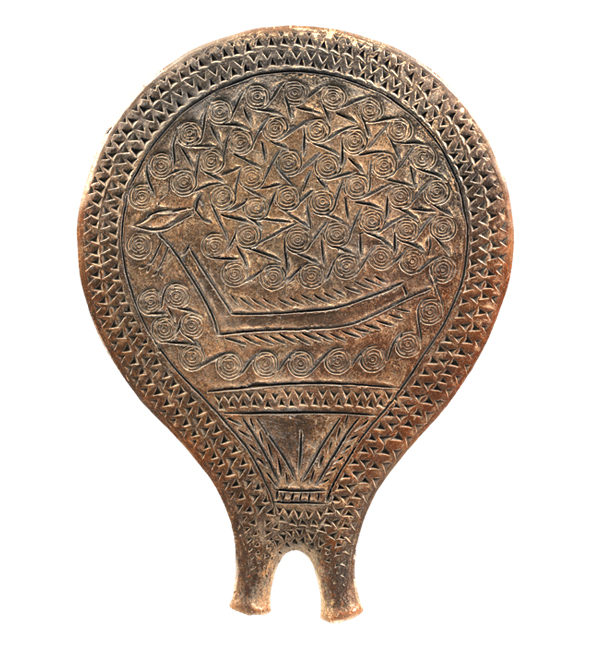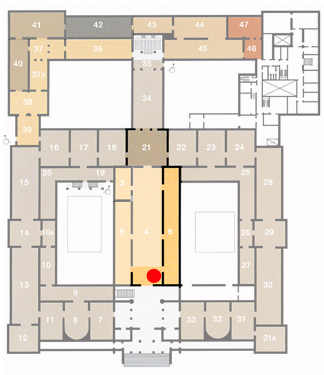Exhibit of the month
Dominating the sea …
Frying pan with representation of a ship
National Archaeological Museum
Collection of Prehistoric Antiquities, inv. no Π4974
Provenance: Chalandriani, Syros (Tomb 174)
Dimensions: Height: 4 cm, Diam. of rim: 28.2 cm
Length (including the handle): 32 cm, Weight: 1.100 gr
Date: Early Cycladic II period (EC II, 2800-2300 BC)
Display location: Cycladic Antiquities, Room 4, Showcase K1
On the underside of the base of this handmade clay frying pan from Syros a Cycladic craftsman incised a ship with 28 oars amid the “frothy” waves as though it was viewed from above. Palaeolithic tools made of obsidian from Melos that were uncovered at Franchthi Cave in the Argolid of the Peloponnese indicate that people travelled across the Aegean Sea already since 11000 BC. However, the earliest known depictions of ships in the Aegean appear approximately 7.000 years later in the Neolithic settlement of Strophila on Andros, followed in a space of approximately 1.500 years by the representation on the frying-pan vessel.
The vessel had been deposited as funerary offering in the cemetery of Chalandriani on Syros that comprised 600 tombs. Together with the ships from the remaining similarly decorated frying pans, unearthed in the same cemetery, form a small fleet of ships without masts but with 24-28 oars. With these 15-20 m long ships the inhabitants of the Cyclades pioneered in the trade of metals across the Aegean and the East Mediterranean. The ship’s tall prow is surmounted by a fish under which a banner is hung. The image of the fish differed on each representation giving the impression that its identity was associated with the symbolism which each kind of fish entailed as an emblem at the acrostolion (extreme part of the prow). The small number of burials furnished with frying-pan vessels may probably reflect the status of their dead possessors as “shipowners”, a view that is further reinforced by the possible use of these vessels as navigational liquid mirrors. Simultaneously, they are associated with ritual enactments, judging from the occurrence of a pubic triangle above the forked handle, without any apparent thematic relevance to the main representation.
The symbolism of the representation for the Cycladic society is more easily deciphered when juxtaposed with a clay vase from Phylakopi of Melos, on which the helmsman of an oared ship is standing on the prow nude with pronounced genitals, in an effort to illustrate male dominance over the sea.
Dr Katia Manteli
Bibliography
Χρ. Τσούντας, 1899. “Κυκλαδικά ΙΙ”, Αρχαιολογική Εφημερίς, pp. 73-134.
C. Broodbank, 2000. An Island Archaeology of the Early Cyclades. Cambridge University Press: Cambridge, pp. 96-106, 212-216.
Χρ. Τελεβάντου, 2005. “Άνδρος” in Α. Βλαχόπουλος (ed.), Αρχαιολογία – Νησιά του Αιγαίου. Melissa Press: Athens, pp. 214-221.
N. Brodie, J. Doole, G. Gavalas and C. Renfrew (eds) 2008. Horizon. Ορίζων. A colloquium on the prehistory of the Cyclades. McDonald Institute Monographs. Stavros Niarchos Foundation. Exeter: Short Run Press (Ch. Televantou: Chapter 6, M. Marthari: Chapter 9, L. Goodison: Chapter 39).
D. A. Papathanassoglou and Ch. A. Georgouli, 2009. “The ‘frying pans’ of the Early Bronze Aegean: An experimental approach to their possible use as liquid mirrors”, Archaeometry 51: 4, August, pp. 658-671.



